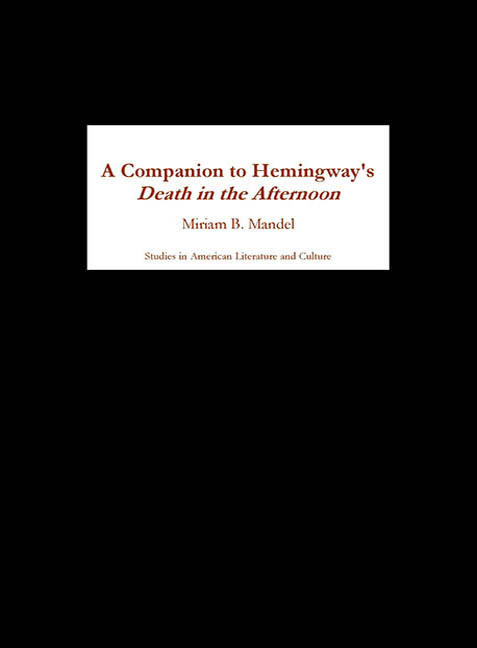Book contents
- Frontmatter
- Dedication
- Contents
- Acknowledgments
- Hemingway Works That Address the Bullfight
- A Note on the Text of Death in the Afternoon
- Introduction
- Composition, Sources, and Backgrounds
- Reading Texts, Paratexts, and Absence
- On Authorship and Art
- “Prejudiced through Experience”: Death in the Afternoon and the Problem of Authorship
- “The Sequence of Motion and Fact”: Cubist Collage and Filmic Montage in Death in the Afternoon
- And What Came After
- Works Cited
- Notes on the Contributors
- Index
“The Sequence of Motion and Fact”: Cubist Collage and Filmic Montage in Death in the Afternoon
from On Authorship and Art
Published online by Cambridge University Press: 27 April 2017
- Frontmatter
- Dedication
- Contents
- Acknowledgments
- Hemingway Works That Address the Bullfight
- A Note on the Text of Death in the Afternoon
- Introduction
- Composition, Sources, and Backgrounds
- Reading Texts, Paratexts, and Absence
- On Authorship and Art
- “Prejudiced through Experience”: Death in the Afternoon and the Problem of Authorship
- “The Sequence of Motion and Fact”: Cubist Collage and Filmic Montage in Death in the Afternoon
- And What Came After
- Works Cited
- Notes on the Contributors
- Index
Summary
Although Hemingway commented to Max Perkins that he did not go to movies, his statement is inaccurate, and in fact the impact of film is quite apparent in his writing. One of the most lyrical passages in Death in the Afternoon creates its effect by juxtaposing images that are not narratively or chronologically connected, as if it were a film montage. It appears in the last chapter of Death in the Afternoon:
The Prado, looking like some big American college building, with sprinklers watering the grass early in the bright Madrid summer morning; the bare white mud hills looking across toward Carabanchel; days on the train in August with the blinds pulled down on the side against the sun and the wind blowing them; chaff blown against the car in the wind from the hard earthen threshing floors; the odor of grain and the stone windmills. (270)
Like the filmic montages that Hemingway saw in D. W. Griffith's Birth of a Nation (1915), this passage builds to a powerful emotional climax by piling up disparate images that mix sense impressions (the brightness of the sun, the warmth of summer, the dryness of chaff, the odor of grain), connote motion (of sprinklers, of a train, of the wind), and thus build to an emotional whole that is more than the sum of its parts. This “sequence of motion and fact” (DIA, 2) puts “everything in,” not by leaving something out, but by combining fragments of experience into a new, larger whole.
This new whole poses new questions: How do we unravel the condensation of time, place, and space in this dense conglomerate? How do we read this new kind of map? One key lies in understanding the workings of montage, particularly filmic montage, in Death in the Afternoon. The deliberate juxtapositions of montage work to alter or disrupt conventional relations between time, space, and the audience, to alter the way we read history. Death in the Afternoon is, among other things, a history of bullfighting — not a complete history, but a recounting of the state of the art — between approximately 1900 and 1932, a moment in time when history seemed to be very out of joint. By 1932, Hemingway had already wrestled with the problem of making the short story and novel represent the reality of the Lost Generation.
- Type
- Chapter
- Information
- A Companion to Hemingway's Death in the Afternoon , pp. 257 - 280Publisher: Boydell & BrewerPrint publication year: 2004



